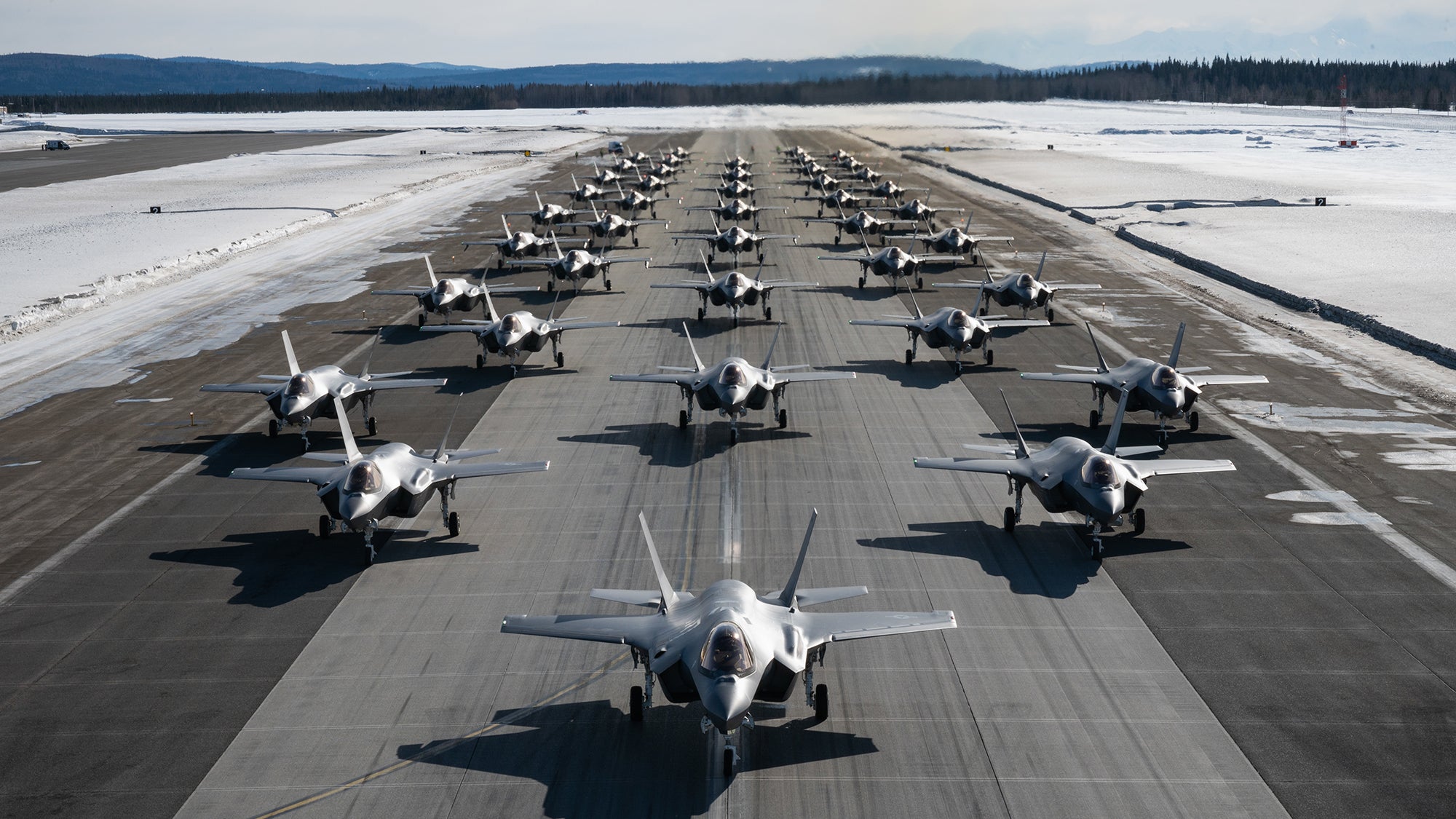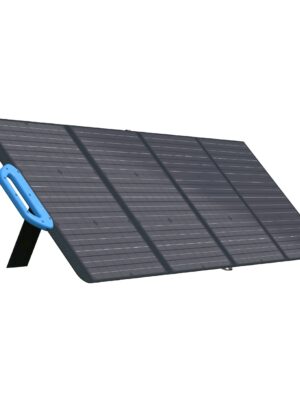A remote Alaskan Air Force base is getting a small nuclear reactor
On August 31, the Air Force announced that a California company called Oklo would design, construct, own, and operate a micro nuclear reactor at Eielson Air Force Base in Alaska. The contract will potentially run for 30 years, with the reactor intended to go online in 2027 and produce energy through the duration of the contract. Should the reactor prove successful, the hope is that it will allow other Air Force bases to rely on modular miniature reactors to augment their existing power supply, lessening reliance on civilian energy grids and increasing the resiliency of air bases.
Located less than two degrees south of the Arctic Circle, Eielson may appear remote on maps centered on the continental United States, but its northern location allows it to loom over the Pacific Ocean. A full operational squadron of F-35A stealth jet fighters are based at Eielson, alongside KC-135 jet tankers that offer air refueling. As the Department of Defense orients towards readiness for any conflict with what it describes as the “pacing challenge” of China, the ability to reliably get aircraft into the sky quickly and reliably extends to ensuring that bases can have electrical power at all times.
“If you look at what installations provide, they deliver sorties. At Eielson Air Force base they deliver sorties for F-35 aircraft that are stationed there,” Ravi I. Chaudhary, Assistant Secretary of the Air Force for Energy, Installations, and Environment, tells Popular Science via Zoom. “But if you think about all that goes with that, you’ve got ground equipment that needs powering. You’ve got fuel systems that run on power. You’ve got base operations that run on power. You’ve got maintenance facilities that run on power, and that all increases draw.”
And it’s not just maintenance facilities that need power, Chaudhary points out; the base also houses communities that live there, go to school there, and shop at places like the commissary.
While the commissary may not be the most immediately necessary part of base operations, ensuring that there’s backup power to send the planes into the air, and take care of families while the fighters are away, is an important part of base functioning.
But in the event that the base needs more power, or an independent backup source, bases often turn to diesel generators. Those are reliable, but come with their own logistical obligations, for supplying and maintaining diesel generators, to say nothing of the carbon impact. As a promotional video for the Eielson micro-reactor project notes, the military is “the nation’s largest single energy consumer,” which understates the outsized role the US military has as a producer of greenhouse gasses and carbon emissions.
This need is where the idea of a small nuclear reactor comes into play.
“When you have a core micro reactor source that can provide independent clean energy to the installation, that’s a huge force multiplier for you because then you don’t have to rely on more vulnerable commercial grids,” says Chaudhary. These reactors would facilitate a strategy Chaudhary called “islanding,” where “you take that insulation, you sequester it from the local power grid, and you execute operations, get your sorties out of town and deploy.”
The quest for a modular, base-scale nuclear reactor is almost as old as the Air Force itself. In the 1950s, the US Army explored the idea of powering bases with Stationary Low-Power Reactor Number One, or SL-1. In January 1961, SL-1 tragically and fatally exploded, killing three operators. The Navy, meanwhile, successfully continues to use nuclear reactor power plants on board some of its ships and submarines.
In this case, for its Eielson reactor, the Air Force and Oklo are drawing on decades of innovation, improvement, and refined safety processes since then, to create a liquid-metal cooled, metal-fueled fast reactor that’s designed to be self-cooling when or if it fails.
And importantly, the Air Force is starting small. The announced program is to design just a five megawatt reactor, and then scale up the technology once that works. It’s a far cry from the base’s existing coal and oil power plant, which generates over 33 megawatts. Adding five megawatts to that grid is at present an augmentation of what already exists, but one that could make the islanding strategy possible.
If a base can function as an island, that means attacks on an associated civilian grid can’t prevent the base from operating. This works for attacks with conventional weapons, like bombs and missiles, and it should work too for attempts to sabotage the grid through the internet, like with a cyber attack. Nuclear attack could still disrupt a grid, to say nothing of the resulting concurrent deaths, but Chaudhary sees base resilience as its own kind of further deterrent action against such threats.
“We’ve recognized in our national defense strategy that strong resilient infrastructure can be a critical deterrent,” says Chaudhary. “Our energy is gonna be the margin of victory.”
Please Support Our Sponsors
Solar Power Generator Discounts Along With Free Shipping
- 10% OFF for Jackery Solar Generator 2000 Pro Series with code "JADEAL"
- 10% OFF for Jackery SolarSaga 200W Solar Panel with code "JADEAL"
- 10% OFF for Jackery Solar Generator 1500 Series with code "JADEAL"
- 10% OFF for Jackery Solar Generator 1000 Series with code "JADEAL"
- 10% OFF for Jackery Explorer 1500 Portable Power Station with code "JADEAL"
- 10% OFF for Jackery Explorer 1000 Pro Portable Power Station with code "JADEAL"
- 10% OFF for Jackery Explorer 500 Pro Portable Power Station with code "JADEAL"
- 10% OFF for Jackery Explorer 300 Pro Portable Power Station with code "JADEAL"
- 10% OFF for Jackery SolarSaga 100W Solar Panel with code "JADEAL"

The University of Georgia is represented by the Georgia Bulldogs . The Bulldogs participate in the Southeastern Conference's (SEC) Eastern Division of the NCAA.
They play their home games in the storied Sanford Stadium in Athens, Georgia. The first season in Georgia was in 1892. In 1942, 1980, and 2021, the Georgia Bulldogs won three national championships.
The Georgia Bulldogs have additionally been crowned the National Champion in four additional seasons by at least one polling organization (1920, 1927, 1946 and 1968).
The Georgia Bulldogs are tied for second place in conference history with their 15 conference titles, including 13 SEC titles, and their 59 bowl appearances, which ranks second all-time.
In addition, the program has produced five top picks in the National Football League (NFL) draft, two Heisman Trophy winners, numerous winners of various national honors, and many others.

Longhorns football represents the University of Texas in Austin often known as Texas, UT or the Texas Longhorns. The Longhorns represent the Big 12 Conference in the NCAA Division. They play in Austin, Texas, at the Darrell K. Royal-Texas Memorial Stadium.
The Texas Longhorns are ranked third and seventh, respectively, in terms of all-time wins and win-loss records, with over 900 victories and an overall win-loss percentage of.705.
The legendary program also boasts four national titles, 32 conference titles, 100 First Team All-Americans, and two Heisman Trophy winners.
Get your Texas Longhorns Revival T-Shirt today. The Texas Longhorns Rustic Revival shirt is also a fan favorite.
Many college sports fans like to wear their gear all around town, get your Texas Longhorns Centered gear and show your support.





 Gettr
Gettr














